The Ultimate Projector Screen Buying Guide

This Guide Contains Everything You Need To Know About Buying The Best Projector Screen For Your Needs. Ready To Check It Out? Let's Do It!
So, you're interested in learning about projector screens? Maybe it's your first time buying one, or perhaps you are looking to upgrade your current screen.
Nothing is more frustrating to a consumer than buyer's remorse and shopping for movie screens can be challenging due to all of the choices you need to make and technical jargon.
What size should I get? What’s screen gain? Why do I need a 4K projection screen? Screens come in different colors?!?
The goal of this in-depth guide to projector screens is to help you fully understand the type of screen you need to fit your demands, so that in the end, you are thrilled with your choice.
Projector Screen Quick Tips
If you just need some quick pointers here are the most important things to consider before buying a projector screen. We’ll go into each of these points in greater detail in our screen guide below:
-
Bigger Is Better (Usually):
- No one has ever said, “I wish I got a smaller screen.”
- In general, larger screens offer a more immersive viewing experience, particularly in home theaters.
- Consider the viewing distance and room size to determine the optimal screen size for your space.
-
Aspect Ratio And Screen Dimensions:
- If you plan to watch TV and movies opt for a 16:9 screen to best match HDTV content formats.
- If you plan to almost exclusively watch movies, get a Cinemascope screen
- Choose a 16:10 screen for lessons and presentations, providing extra vertical space for data, slides and documents.
-
Invest In A Textureless 4K Screen:
- Select a textureless 4K projector screen to ensure maximum clarity and detail of 4K content, otherwise you’re not allowing your 4K projector to reach its full potential.
- Textured screen materials can degrade image quality and introduce distracting artifacts. This also happens when you project onto a wall.
-
Bedsheets Are Not Screens:
- While tempting as a quick fix, using a bedsheet as a projector screen leads to poor image quality, wrinkles, and uneven projection (and more laundry.)
-
Special Features Exist To Make Your Experience Better:
- Ambient light rejecting projector screens allow you to watch TV and movies with the lights on.
- Acoustically transparent screens allow you to put your speakers behind your screen.
- Rear projection surfaces allow you to project from behind the screen.
-
Bundle Your Projector And Screen To Save:
- Some retailers offer discounts or bundled pricing when purchasing your projector screen together with your projector.
What Is A Projector Screen?
Simply put, a projector screen is a specially designed flat surface upon which the image from a video projector is displayed.
Home cinema screens are made to reflect the images from a projector onto a large surface area, generally for cinematic, gaming or presentation purposes. They typically enhance the brightness and clarity of the projected image, giving you the best picture possible. These screens come in a number sizes and types including wall-mounted, tripod, motorized and retractable film screens.
What Is The Benefit Of Using A Screen For Projectors?

We often get asked, "Why do I need a screen for my projector?" The answer is clear. If you want to get the most out of your projector can produce you need to use a projector screen. Dedicated projection surfaces are made with optical coatings that enhance their reflective properties thus giving you the best picture possible. Screens offer a number of advantages including:
-
Higher Image Resolution/More Detail
A premium projector screen is designed to reveal your high-resolution projector’s full capability. A projector’s true resolution is only visible to the viewer when it reaches a surface that does not impede the integrity of the pixels.
Any surface that lacks absolute flatness, and/or has any kind of texture that has a gradient larger than the projector’s pixel’s individual dimensions, has the potential to disrupt and distort the pixel’s geometry.
While your eye will never see a single distorted pixel, without a movie screen, you will likely be able to detect a lack of sharpness, clarity and dynamics when compared with a premium screen that is properly calibrated to your projector’s high resolution.
-
Color Accuracy
A quality projector screen is properly calibrated to not influence the color balance of the projected image. While it would seem that white is white and gray is gray, the fact of the matter is within the spectrum of white and gray there are instances of tinting where the white balance can tilt slightly to the yellow spectrum or slightly to the blue spectrum. A quality projector screen will not have this effect as its surface is perfectly calibrated to have no color-shifting influence.
-
More Brightness (Or Less Brightness)
Another advantage of home cinema projector screens is that their gain levels can be selected to benefit your viewing experience. Often with a larger size screen one will want to consider increasing the gain level in order to maintain brightness of the image. Similarly, if you want to enhance the black levels of your image you may wish to decrease the gain.
-
Smooth Image
Premium indoor projector screens are free of texture. By being texture-free, the resulting image will pop more, since the geometry of the pixels from the projector will not be distorted or changed. When projected pixels hit a textured surface, the result can appear noisy or even rigid since the surface is not free of texture. Having a smooth screen texture allows you to project video that has a 4K resolution and beyond. The defects are even more highlighted on a seemingly "flat" wall.
Is There A Downside To Using A Projector Screen?
There are only two disadvantages of using a projector screen. One is the cost of a high-grade display. The other is lining up the projector and screen would take a bit longer than not having a screen. But if you care one iota about having a quality image an indoor cinema screen more than makes up for it. One look at the breathtaking detail of a 120 inch 4K projector screen and you’ll know right away your purchase is worth it.
Who Should Buy A Projector Screen?
Perhaps you are a teacher looking for a screen to show slides and educational videos to your students. Or maybe you are a business professional who will be using their projector more for PowerPoint and Excel presentations. Or maybe you are a movie aficionado looking to blow your friends' minds at your next party.
Depending on your needs, we are confident we can find the perfect projector screen for you!
The people who need large projection surfaces typically fall under a few categories:
- Home theater - A home theater projection screen is perfect for individuals who want a dedicated cinema room, backyard movie nights and those who want a movie theater experience right in their living room.
- Large venues - Large venues such as conventional halls are the ideal setting for a large movie screen.
- Business conference rooms - When it comes to presenting multimedia data nothing conveys the point better than a large projection screen.
- Classrooms - From elementary to college, schools can benefit from large screen projectors to help students learn.
- Churches and houses of worship - Whether it’s a projector for church services or a fundraising movie night, church projector screens are the way to go.
Can I Use A Bedsheet As A Projector Screen?

We often get asked “Can I use a sheet as a projector screen?” or “Can I project on a plain white wall?” Technically you can project on anything, but should you? No.
A projector in theory works without a screen. But you’re not gonna get the most out of your projector. Making use of a dedicated video projector screen will help you accomplish just that.
Using A Wall
The problem with projecting on a wall is that while they look it, the surface really isn’t perfectly flat.
A plain wall doesn’t reflect light as well as a screen can. This will negatively affect the clarity of the picture being projected and even distort or blur the image.
A wall also has blemishes, bubbles and paint drips. Each of these is going to be highlighted when the light from a projector hits them. These blemishes will ruin your viewing experience.
Using A White Bed Sheet
A bed sheet is even worse than projecting on a wall because you’ll see every ripple and wrinkle. Not to mention much of the light will go right through the fabric giving you a dull washed out image.
If you want to do justice for your projector you need to get a cinema quality screen!
How Do Projector Screens Work?
There are several types of projector screens available, but most work on the same basic principle. The screen surface is made of a reflective material that is specifically designed to reflect light from a projector back toward the audience. This reflective material can be made of a variety of materials, including vinyl, glass beads, and fabric.
When light from a projector hits the screen surface, it is reflected back toward the audience. The amount of light that is reflected depends on several factors, including the type of reflective material used, the angle of the projector, and the ambient light in the room. For example, if the ambient light in the room is very bright, it may be more difficult to see the image on the screen. But as we'll cover later, there are ways around this.
What To Know Before Buying A Projector Screen
There are a number of factors that will help you find the best projector screen to meet your needs. What type of projector do you have, how bright is the room, how big is the room, what type of screen do you need, where will you put the screen and most importantly what size theater screen do you want/need?
Type Of Projector
There is a chance you already have the projector you need, or you have an idea of which projector you are going to get. If you order your projector from ProjectorScreens.com, you can be sure you’ll buy the right projector and screen together and at the best price. You can also learn everything you need to know with out projector buying guide
The type of projector you buy certainly influences what screen you should get.
The size of the lens on the projector will determine how large the image can be projected.
Projector Screen Resolution
The projector's resolution is also very important factor in determining the right screen to get. If you’re building a home theater you’ll want to watch a movie theater quality image. In order to achieve this you need to buy a 4K projector. While you might think any flat surface will give you an immersive cinematic experience, this just isn’t the case. The pixels from a 4K projector are very, very tiny so if you don’t have a perfectly flat projection surface you’re going to see pixel distortions. A higher quality 4K projector may not work well on a basic matte finish.
To get the most out of your projector you need to get a 4K projector screen that supports the UHD resolution. These 4K cinema screens are completely textureless giving you a flat surface to project onto. This allows the screen to resolve the UHD image the way it was meant to be seen.
One recommendation when it comes to movie screen resolution is to get a higher supported resolution than your video projector. By getting a 16K or 8K projector screen, you’ll future proof your display investment for the next generation of projectors.
If you aren't sure of the lens size or resolution, consult with the user manual that came with your projector.
If you are planning to get an ultra short throw projector you’ll want to make sure you get a UST projector screen to get the best visuals possible.
The Lighting In The Room
Lighting is extremely important in determining the type of material your projection surface should be made of.
Screens are meant to not only reflect light sent from the projector, but also to use the ambient lighting in the room for the best picture quality. Are you able to completely block out all outside lighting?
If your room has a lot of ambient light you likely need to get an ambient light rejecting projector screen.
We’ll cover ALR screens lower down or you can check out our in-depth article explaining how ambient light rejecting screens work.
The Size Of The Room
If you have a larger room, you can position the seating so that people are more centered in front of the display, and your screen can reflect more light. If you have a smaller room where people will be spread out viewing your projection surface from all angles, you will need a screen that projects less light so that your entire audience will be able to see the images clearly. The type of material you select will have a serious impact on your audience.
Where Will You Be Putting The Projector Screen?
There are a number of options for where you can place your home theater screen. This of course depends on what you plan to do with your screen. Will you be using it as a home theater projector or is it going to be a backyard movie projector, or will you be using a projector for business presentations?

Ceiling Projector Screens
Ceiling mounted projector screens are displays that, as the name implies, descend or hang from the ceiling. Most ceiling projector screens are retractable, so they fall under the category of either electric or manual screens.
Ceiling screens are a great choice for both businesses and home theaters thanks to their more elegant look compared to a freestanding tripod. The most popular type of canopy display is a recessed screen that is housed in the ceiling.
- Build a Bundle

$6,450.00
- Status: Leaves Warehouse within 1-2 Business Days
- Mount Type: ["Ceiling"]
- Viewable Diagonal: 120.0
- Gain: 0.6
- Viewable Height: 58.0
- Viewable Width: 104.0
- Build a Bundle
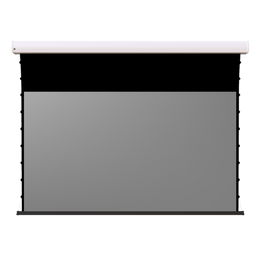
$6,343.00
- Status: Leaves Warehouse within 1-2 Business Days
- Mount Type: ["Ceiling"]
- Viewable Diagonal: 110.0
- Gain: 0.6
- Viewable Height: 54.0
- Viewable Width: 96.0
- Build a Bundle
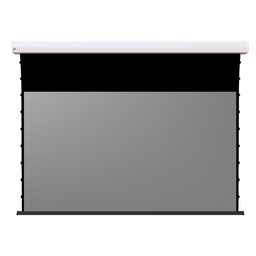
$6,343.00
- Status: Leaves Warehouse within 4-6 Weeks
- Mount Type: ["Ceiling"]
- Viewable Diagonal: 106.0
- Gain: 0.6
- Viewable Height: 52.0
- Viewable Width: 92.0
Recessed Ceiling Screens
Recessed ceiling screens retract into housing hidden in the ceiling. They are the sleek go to option for people who want a clean aesthetic. A ceiling recessed projection screen is completely hidden from view and is the ideal solution for boardrooms, lecture halls and home theaters, where a non-permanent display is desired.
There are typically two options available, one with an enclosure door to cover the display once it’s been retracted and one without. Both options maintain a seamless appearance in your home theater or conference room.
Installing a cinema screen in your ceiling generally requires the assistance of a contractor or an electrician.
Wall Projector Screens
A wall mounted projector screen is one that is permanently installed on the wall. These are some of the most popular options for dedicated home theater rooms because they are the centerpiece of the cinema space.
Most projection screens mounted on a wall are fixed frame and are hung like a painting; but there are some wall and ceiling mounted screens that are retractable.
- Sale
- Build a Bundle
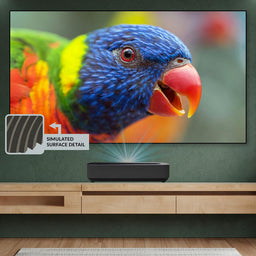
$1,499.00
- Status: In Stock
- Mount Type: ["Wall"]
- Viewable Diagonal: 120.0
- Viewable Height: 58.8
- Viewable Width: 104.6
- Sale
- Build a Bundle
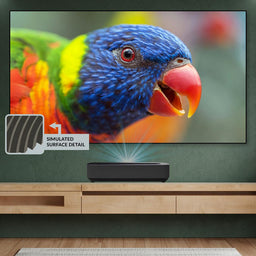
$799.00
- Status: In Stock
- Mount Type: ["Wall"]
- Viewable Diagonal: 100.0
- Viewable Height: 49.0
- Viewable Width: 87.0
- Sale
- Build a Bundle
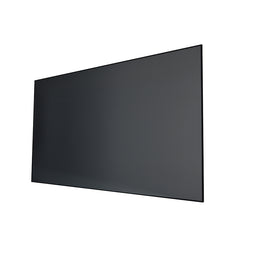
$1,899.00
- Status: In Stock
- Mount Type: ["Wall"]
- Viewable Diagonal: 120.0
- Gain: 0.5
- Viewable Height: 58.8
- Viewable Width: 104.6
Outdoor Screens

Whether it’s a small evening of family time in the backyard or a church fundraiser with the whole community, one of the most fun summer activities is a movie night under the stars using an outdoor projector screen. Ranging from small, medium, large to huge, there's a size for every application. Set one up in your yard, flip on the projector, and watch the latest movies in the fresh air, instead of cramped around a couch indoors.
You want to get a screen that's made for the outdoors because it’s going to be more resistant to fluctuations to weather, humidity and rain.
While a DIY outdoor movie screen sounds fun. The picture quality is horrendous compared to a dedicated display.
There are a few types of outdoor movie screens. You have permanent outside screens for your patio, garden or under an awning. These open air displays are typically retractable in weather resistant housings to protect them from the elements. The Draper Nocturne+ E outdoor projector screen is a great example of a display perfect for nighttime entertainment.
Portable screens are another type of outside movie displays. One of the most popular is the Elite Screens Yardmaster. This affordable and easy to set up foldable movie screen is perfect for picnics, barbeques and camping trips.
In the great outdoors bugs are going to be attracted to the light on the screen. If you’re using a retractable screen remember to clean off the surface before you roll it up or you might find crushed bugs on your display the next time you use it.
The third type of screen for the outside are inflatable movie screens.
Inflatable Projector Screens
Have you ever been to a drive-in movie theater? You get to watch an indoor theater quality picture while enjoying the outdoors- the best of both worlds!
Ever wonder how you can do that in your own backyard without trying to ruin all of your white sheets by attaching them to the side of your house and getting an awful picture quality? Look no further!
Inflatable beamer screens are the latest craze sweeping the nation. For a very affordable price, these movie screens self-inflate in minutes and can be adjusted to fit a variety of viewing angles.
The picture quality is great, and the screen and base materials are made to withstand hot and cold outside temperatures, rain and even some wind!
The only negative to come along with inflatable movie screens… trying to get your guests to stop watching movies and leave at the end of your party!
Inflatable projector screens are a good choice for town and municipalities wanting to have a public movie night. Inflatable screens allow you to pack the display surface up easily while offering a tremendously large surface area.
Tabletop Projection Screens

If you’re making a business presentation on the road or at a convention your laptop isn’t going to impress. A tabletop display will give your presentation a refined polished look that will help you seal the deal. Desktop projection surfaces are typically much smaller than their wall mounted counterparts.
Types Of Screens
Are you looking for a permanent screen, a pull-down screen, an electric screen or a portable screen? Will your pull-down screen or electric screen be ceiling-mounted, wall-mounted or recessed ceiling-mounted?
These are the different types of projector screens:
Fixed Frame Projector Screens

Fixed Frame Projector Screens are arguably the most elite of all cinema screens. Although they can be used for commercial purposes, these screens are commonly found in the most impressive of home theaters.
These screens cannot be rolled up and down and are a permanent fixture in the room. These projector screens are so popular in home theaters because they tend to last the longest, since they aren't constantly being rolled up and down in between uses. You won't get the bends and waves in these screens like you might in other types of screens.
These projector screens also tend to have the best picture quality, since these screens have the widest variety of screen material to choose from. While a tab-tensioned, electric, recessed ceiling-mounted movie screen might look a little cooler when the screen appears, the picture quality and overall impressiveness make the fixed frame cinema screen the mother of all projector screens.
Of course, those factors also tend to make these screens among the most expensive. The Elite Screens ezFrame & SableFrame are extremely popular and affordable fixed screens. But if you want the best picture quality look at the Screen Innovations 3 Series Fixed and the Da-Lite Cinema Contour.
![Elite Screens Aeon AR138H-CLR5 138 diag. (67.6x120.3) - HDTV [16:9] - StarBright - 0.8 Gain](http://www.projectorscreen.com/cdn/shop/files/AeonCLR5.jpg?v=1760473295&width=256)
$2,412.00
- Status: Leaves Warehouse within 1-2 Business Days
- Screen Type: Fixed Frame
- Mount Type: ["Wall"]
- Viewable Diagonal: 138.0
- Gain: 0.8
- Viewable Height: 67.6
- Viewable Width: 120.3

$5,500.00
- Status: Leaves Warehouse within 2-3 Weeks
- Screen Type: Fixed Frame
- Mount Type: ["Wall"]
- Viewable Diagonal: 130.0
- Gain: 0.6
- Viewable Height: 63.8
- Viewable Width: 113.3
![Elite Screens Aeon AR150H-CLR5 150 diag. (73.6x130.7) - HDTV [16:9] - StarBright - 0.8 Gain](http://www.projectorscreen.com/cdn/shop/files/AeonCLR5.jpg?v=1760473295&width=256)
$3,288.00
- Status: Leaves Warehouse within 1-2 Business Days
- Screen Type: Fixed Frame
- Mount Type: ["Wall"]
- Viewable Diagonal: 150.0
- Gain: 0.8
- Viewable Height: 73.6
- Viewable Width: 130.7
Retractable Projector Screens
Retractable projector screens come in three varieties: Motorized and manual which are pull down screens and floor rising where the display is pulled up. Each one comes with their own benefits and drawbacks.
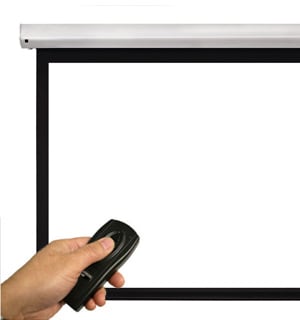
Motorized Projector Screens
Electric Motorized Projector Screens offer a very professional look for your presentations or home theaters. Operated by remote control, they have a sleek, elegant design and the single location provides the most convenience for storage.
An electric projector screen is a popular choice for those who want the convenience of a large movie screen and have a large, semi-permanent area to dedicate to the screen.
Electric movie screens can be mounted into the floor, wall or ceiling. The ceiling mount can also be recessed into the ceiling so that your audience won't know there is a projection screen there while not in use.
Certain motorized cinema screens come with wood trim around the top, which helps mask the screen while not in use and is a great option if recessed ceiling mounting isn't an option for you.
Electric projector screens generally run on 100 volts, but some may be available with 220 volts. Other screens even have the option of remote operation from any location. Automatic screens are also available in tab-tensioned and non-tensioned models.
A recessed ceiling screen will give you the most stylish look, and is a great option if you are not planning on relocating the theater screen. However, a mounted screen provides more flexibility.
If you want the best motorized projector screens look at the Stewart Filmscreen Luxus or Screen Innovations 3 Series Motorized. The EluneVision Reference Studio 4K and Da-Lite Advantage Electrol are both great economical choices.
- Build a Bundle
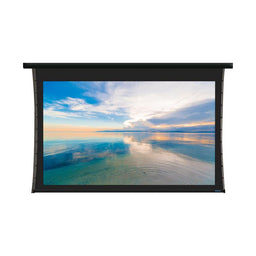
$4,300.00
- Status: Leaves Warehouse within 4-6 Weeks
- Screen Type: Electric
- Mount Type: ["Wall and Ceiling"]
- Viewable Diagonal: 123.0
- Gain: 1.3
- Viewable Height: 65.0
- Viewable Width: 104.0
- Build a Bundle
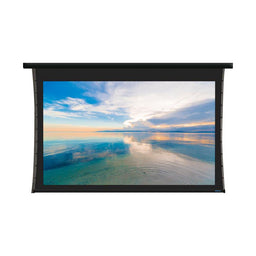
$6,747.04
- Status: Leaves Warehouse within 10-12 Weeks
- Screen Type: Electric
- Mount Type: ["Wall and Ceiling"]
- Viewable Diagonal: 150.0
- Gain: 1.1
- Viewable Height: 73.5
- Viewable Width: 130.75
- Build a Bundle

$8,807.37
- Status: Leaves Warehouse within 10-12 Weeks
- Screen Type: Electric
- Mount Type: ["Wall and Ceiling"]
- Viewable Diagonal: 100.0
- Gain: 1.0
- Viewable Height: 49.0
- Viewable Width: 87.0

Manual Projector Screens
A Manual Projector Screen is an excellent alternative for those looking for a less expensive movie screen. These versatile video projection screens have a pulley at the bottom of the screen, which allows the operator to manually pull the screen up and down. Most of these screens now have a controlled return feature so that the screen's can't be rolled up too quickly, which could cause damage to the screen.
Similar to electric film screens, these can be wall-mounted, ceiling-mounted or ceiling recessed-mounted. However, these screens are much lighter than electric screens, since there are no motors attached. Also, since there is no risk of the motor breaking, failing or wearing over time, these screens require less upkeep.
Most people remember these screens from their school classrooms, wall-mounted above the chalkboard. These theater screens are hugely popular in schools and government buildings. They can also be a great option for a home theater system. That is … if you could live without the convenience of a remote control.
These movie theater screens can also be tensioned or non-tensioned. The non-tensioned are less expensive, but sometimes end up bending down and folding due to wear and tear from pulling the screen down so often. The Da-Lite Contour Manual with CSR and Draper Acumen are two of the most popular models.
![Da-Lite Model C 79043 - 159" diag.(78x139) - [16:9] - Matte White - 1.0](http://www.projectorscreen.com/cdn/shop/files/model_c_8db24fe1-f4b9-4628-8323-56bb7cd469d2.jpg?v=1753806722&width=256)
$1,248.00
- Status: Leaves Warehouse within 4-6 Weeks
- Screen Type: Manual
- Mount Type: ["Wall and Ceiling"]
- Viewable Diagonal: 159.0
- Gain: 1.0
- Viewable Height: 78.0
- Viewable Width: 139.0
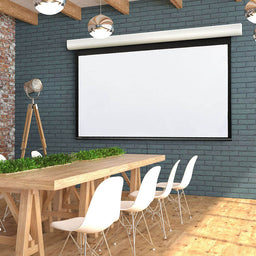
$1,904.00
- Status: Leaves Warehouse within 4-6 Weeks
- Screen Type: Manual
- Mount Type: ["Wall and Ceiling"]
- Viewable Diagonal: 161.0
- Gain: 0.8
- Viewable Height: 79.0
- Viewable Width: 140.0
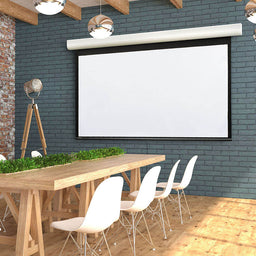
$1,904.00
- Status: Leaves Warehouse within 4-6 Weeks
- Screen Type: Manual
- Mount Type: ["Wall and Ceiling"]
- Viewable Diagonal: 161.0
- Gain: 1.0
- Viewable Height: 79.0
- Viewable Width: 140.0

Floor Rising Projector Screens
Tripods tend to be bulkier and are a bit more difficult to put together. Floor rising projector screens are a great alternative to more cumbersome tripod screens.
A floor rising screen is more lightweight and more simple to set up/take down. A floor rising projector screen comes in one piece- no assembly is required. Many don't even have a carrying case, as a handle is mounted to the base of the screen for easy accessibility. All you need to do is set the feet up on the display surface.
To do that, you simply twist the feet around so that they run perpendicular to the presentation screen. Once the feet are set up, you can just pull the screen up. The screen has a spring roller in place on the back of the film screen that rises with the screen to provide a sturdiness to the screen when it's at maximum height. It acts similar to the rod of the tripod that holds the screen up.
Most of these screens are available in a manual version, where the operator pulls the screen up themselves. However, some versions come with a pneumatic option, which allows you to use a remote control to lift the screen from the base.
The Da-Lite Floor Model is a great place to start.
- Build a Bundle
![Vividstorm S Lite Hyper Motorized Floor Rising ALR Projector Screen for Ultra Short Throw Projectors 150 Inch - VWSDSTLST150H - White - [CUSTOM]](http://www.projectorscreen.com/cdn/shop/files/SLiteHyper-White_b9d1dd4a-ec65-4161-b61a-72294c22b3ab.jpg?v=1753817337&width=256)
$2,987.00
- Status: Contact Us to Place Order
- Mount Type: ["Floor"]
- Viewable Diagonal: 150.0
- Gain: 0.8
- Viewable Height: 73.5
- Viewable Width: 130.74
- Build a Bundle
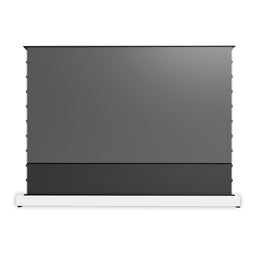
$2,049.00
- Status: Leaves Warehouse within 2-3 Weeks
- Mount Type: ["Floor"]
- Viewable Diagonal: 120.0
- Gain: 0.7
- Viewable Height: 58.8
- Viewable Width: 104.6
- Build a Bundle
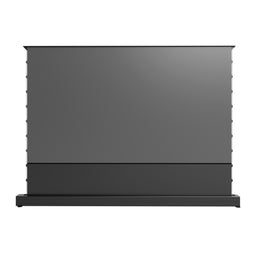
$1,649.00
- Status: Leaves Warehouse within 2-3 Weeks
- Mount Type: ["Floor"]
- Viewable Diagonal: 100.0
- Gain: 0.7
- Viewable Height: 49.1
- Viewable Width: 87.2

Foldable Projector Screens
If you only sometimes need a display set up your best choice is a foldable projector screen. These screens are great for presentations and classrooms where you don’t always want to have the display set up.
Make sure you don’t get a cheap folding screen or you’ll see creases on the surface. With impressive anti-crease technology, premium folding frame projection screens are portable, durable and simple to set up. When you’re done just fold it up and store it away. Simple as that!

$280.00
- Status: Currently Unavailable
- Screen Type: Folding-Frame
- Mount Type: ["Folding Frame / Truss"]
- Viewable Diagonal: 90.0
- Viewable Height: 44.0
- Viewable Width: 78.0
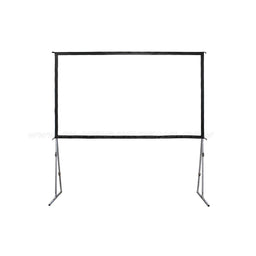
$1,299.00
- Status: In Stock
- Screen Type: Folding-Frame
- Mount Type: ["Folding Frame / Truss"]
- Viewable Diagonal: 200.0
- Gain: 1.1
- Viewable Height: 98.0

$999.00
- Status: In Stock
- Screen Type: Folding-Frame
- Mount Type: ["Folding Frame / Truss"]
- Viewable Diagonal: 180.0
- Gain: 1.3
- Viewable Height: 87.7
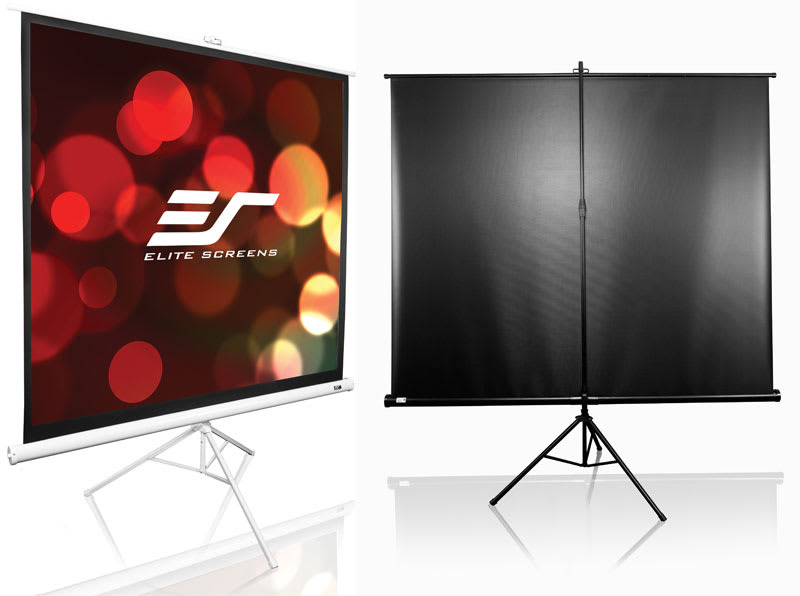
Tripod Projector Screens
A portable projector screen is one of the most popular types of screens, as they don't limit the usage to just one location. Of these portable movie screens, a tripod projector screen is by far the most popular.
A tripod screen comes in two parts: the projector surface itself and the tripod stand that holds the screen up. Both are lightweight and fold down into a small, easy to carry case.
To set up most of these movie screens, you just open up the tripod, which has three legs and a long rod in the middle that extends up the length of the film screen. You connect the rolled up cinema screen to the base of the trip and use the pulley attached to the item to pull the screen up to the top of the tripod rod, where it can be secured. It's as simple as that!
Tripod projector screens tend to be the most cost-efficient, as they are generally the least expensive displays that are meant to withstand more wear and tear. They may not offer the best picture quality though.
The Elite Screens Tripod Series comes in on the low end of the price spectrum, but the high end of the quality one. These tripod projection screens are an excellent value. The Da-Lite Picture King is a tried-and-true workhorse. Often found in rental houses, these tripod screens are built to last and are made in the USA.
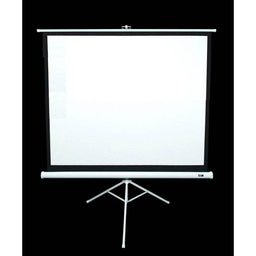
$230.00
- Status: Discontinued
- Mount Type: ["Tripod"]
- Viewable Diagonal: 119.0
- Gain: 1.1
- Viewable Height: 84.0
- Viewable Width: 84.0
![Elite T92UWH Tripod 92 diag. (45x80) - HDTV [16:9] - MaxWhite 1.1 Gain](http://www.projectorscreen.com/cdn/shop/files/Tripod_20White_20Case_d852a0ee-f579-469a-bd1a-c69e11f89604.jpg?v=1753805194&width=256)
$170.00
- Status: Discontinued
- Mount Type: ["Tripod"]
- Viewable Diagonal: 92.0
- Gain: 1.1
- Viewable Height: 45.0
- Viewable Width: 80.0
![Elite T100UWH Tripod 100 diag. (49x87) - HDTV [16:9] - MaxWhite 1.1 Gain](http://www.projectorscreen.com/cdn/shop/files/Tripod_20White_20Case_48d98b67-f492-4945-9a5c-e7485c8502c2.jpg?v=1753805193&width=256)
$179.00
- Status: Currently Unavailable
- Mount Type: ["Tripod"]
- Viewable Diagonal: 100.0
- Gain: 1.1
- Viewable Height: 49.0
- Viewable Width: 87.0

Whiteboard
Projection whiteboards are a handy tool for office or classroom environments. This configuration makes it possible to draw and write directly onto the surface. These whiteboards are specially finished to be paired with a projector and therefore work much better for this purpose than your standard whiteboard which can often be too reflective and/or glossy for a projector.
DIY Projector Screens
A DIY projector screen is cheaper, allowing you to use that savings to upgrade your sound system, or projector. However a diy projection surface is rarely better than a quality store bought one.
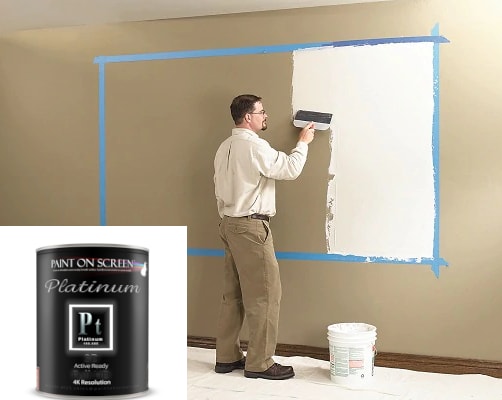
Projector Screen Paint
Projector Screen Paint is a fantastic, newer alternative to an actual movie screen, especially if cost is a factor. One gallon of projector screen paint can provide a surface area between 92" and 240" of diagonal viewing space.
And don't think you need to have permanent wall space in order to use this- you can always paint this onto a large board or other object to create your own portable surface.
Of course, the viewing quality won't be the same as an actual movie screen, but for basic needs, this is a great option. A normal projection screen in that size would cost hundreds just to ship alone and requires multiple people to install. Screen paint allows 1 person to use 1 gallon of paint and 1 roller to create an immersive projection experience.

$268.99
- Status: Leaves Warehouse within 1-2 Business Days
- Screen Type: Paint
- Gain: 2.4

$169.99
- Status: Leaves Warehouse within 2-3 Weeks
- Screen Type: Paint
- Gain: 1.4
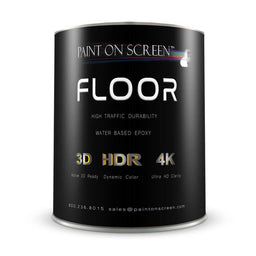
$499.00
- Status: Leaves Warehouse within 2-3 Weeks
- Screen Type: Paint
Projector Screen Material
The projector screen material can make all the difference in the way your image appears. Different surfaces have different reflective properties. Some are cheap and some are quality. The screen materials have different textures and even come in different colors.
What Are Projector Screens Made Of?
Most projector screens are made of vinyl, high grade plastic, spandex, rubber and polyester fabric. You can also find ones made using PVC, canvas and fiberglass. The best projector screens are made using vinyl or spandex.
Regardless of what material is used to manufacture a movie screen, it is coated with magnesium carbonate, titanium dioxide or barium sulfate for enhanced visibility of the light which is directly related to the amount of light which is getting reflected from the surface. When the motion picture industry first took off there was actual silver embedded in the material to make it more reflective. This is where we get the term “the silver screen”.

Projector Screen Colors
Almost all projection screens come in one of three colors: white, gray and black. Each one has it’s advantages and disadvantages.
White Screen
A white projection screen will always be the best option for a room that is totally dark (full light controlled) It will also allow you to watch it from any angle as most gray and black screens have a smaller viewing cone. The white screens are also relatively less expensive.
White screens are also typically better for offices because most content projected in an office has white background. Projecting on a non-white surface just wouldn’t quite look right.
Gray Screen
Gray projection screens tend to have ambient light rejecting properties which allows them to be used in the daylight. They will also have better, richer colors. This improved contrast is why many manufacturers refer to their gray screens as "high-contrast" models. The only downside to grey screens is that depending on the surface, they may have a smaller viewing cone.
Black Screen
Much like the grey ones, black projector screens tend to be ambient light rejecting. Where they really stand out is by having a black surface black movie screens give you the darkest darks and black levels. The down side to black screens is that their white levels are typically somewhat less accurate.
What Is The Best Color For A Projector Screen?
The best projector screen color really depends on where you will be using it, how much light the room has and what you’ll be using it for.
Screen Texture
When it comes to projector screen texture you ideally want a textureless surface. This will give you the best picture quality.
Screen Gain
A projector screen works by reflecting the light back from your projector to your audience's eyes.
The brightness of the image reflected back off of the display's surface is measured in units of "gain", gauging the reflectivity of that surface.
The gain number represents a ratio of light that is reflected back from a surface from a light source.
A screen with a gain measurement of greater than 1.0 infers that the image projected back off of the surface is brighter than the image being projected at the surface.
For example; a movie screen with a gain of 1.5 will project back the light 1.5x brighter than the light being projected at the screen. A 1,000 lumen projector aimed at a screen with 1.5 gain will be perceived at 1,500 lumens. The display achieves this by focusing the light into a more narrow reflective angle, instead of uniformly reflecting the light in all directions. This is why higher gain screens have a smaller viewing angle.
A projector screen with a gain measurement of .8 will reflect back at 80% of the original brightness. That same 1,000 lumen projector will be viewed by the audience at only 800 lumens.
While it might seem like you’d always want a higher gain, brighter doesn’t always mean better. A projector screen with a lower gain has a wider viewing angle so if you have a wider space a lower gain would be better. Lower gain screens also help prevent hotspotting and reflect colors more accurately. Lower gain screens also help to bring out more vivid blacks and enhance a projector's native contrast ratio.
Special Features
Some screens are constructed with special features. These refer to a unique characteristic of a screen’s design, implemented to either improve the projector’s performance or to add further utility to the screen. These premium features will help take your home theater experience to the next level.
Ambient Light Rejecting
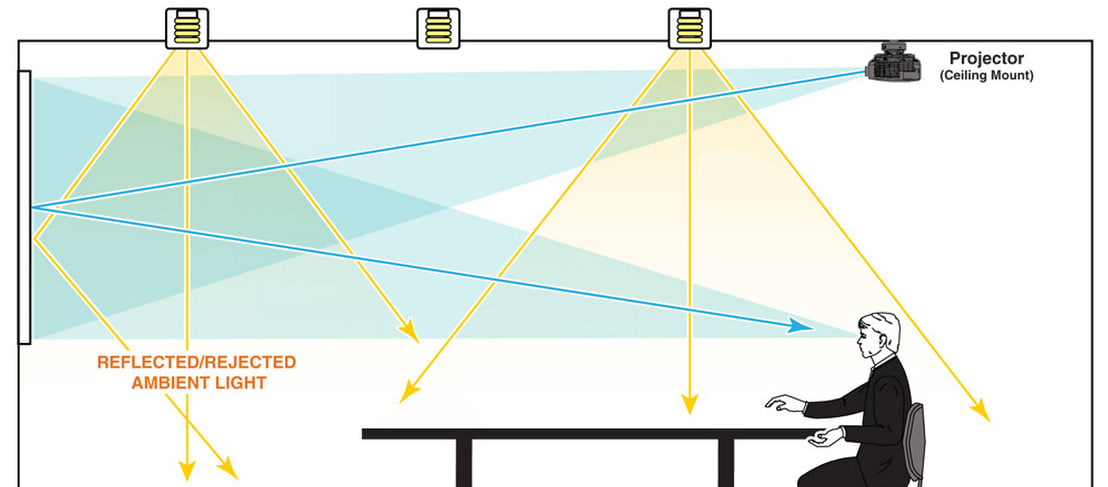
Any light source other than your projector threatens to wash out the image on your display surface. Ambient Light Rejecting or ALR projector screens have a surface that prevents ambient light from washing out a projected image. They achieve this by reflecting the light away from the source using microscopic sawtooth teeth.
These screens are best suited for use in a multi purpose or living room where daytime watching is necessary and black out curtains aren’t available.
You can learn more about ambient light rejecting screens here.
- Build a Bundle
![Vividstorm S Lite Hyper Motorized Floor Rising ALR Projector Screen for Ultra Short Throw Projectors 150 Inch - VWSDSTLST150H - White - [CUSTOM]](http://www.projectorscreen.com/cdn/shop/files/SLiteHyper-White_b9d1dd4a-ec65-4161-b61a-72294c22b3ab.jpg?v=1753817337&width=256)
$2,987.00
- Status: Contact Us to Place Order
- Mount Type: ["Floor"]
- Viewable Diagonal: 150.0
- Gain: 0.8
- Viewable Height: 73.5
- Viewable Width: 130.74
- Build a Bundle

$6,747.04
- Status: Leaves Warehouse within 10-12 Weeks
- Screen Type: Electric
- Mount Type: ["Wall and Ceiling"]
- Viewable Diagonal: 150.0
- Gain: 1.1
- Viewable Height: 73.5
- Viewable Width: 130.75
- Sale
- Build a Bundle

$1,499.00
- Status: In Stock
- Mount Type: ["Wall"]
- Viewable Diagonal: 120.0
- Viewable Height: 58.8
- Viewable Width: 104.6
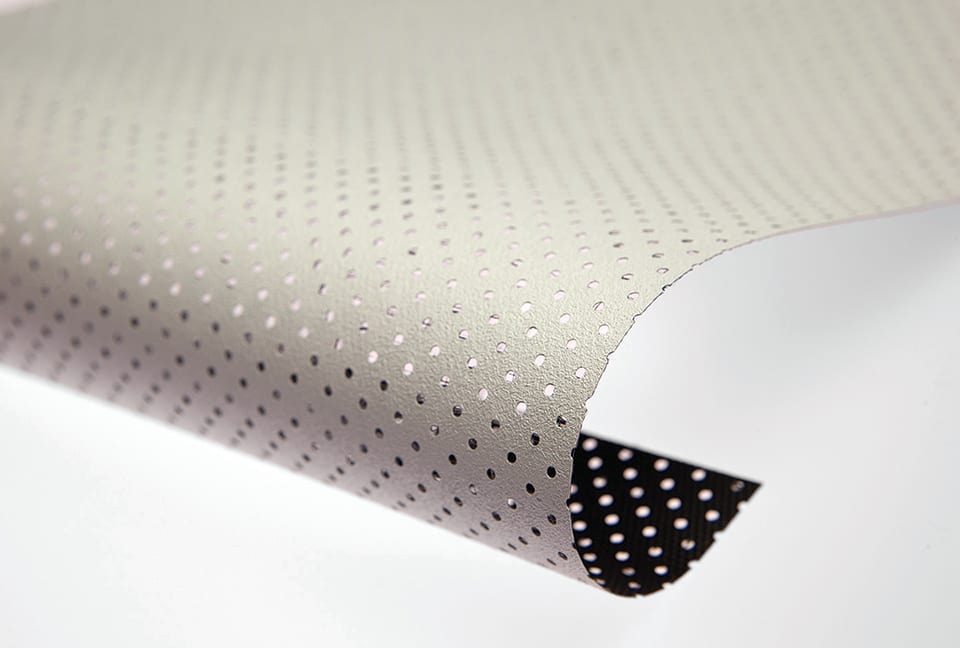
Acoustically Transparent
An acoustically transparent projection screen allows sound to pass through the screen material allowing for speakers to be placed behind the screen, maximizing the viewing and listening experience. There are two types of acoustically transparent cinema screens; Woven and Perforated.
Woven screens use a porous surface (like a bed sheet) which allows sound to pass in and out. There are two disadvantages to this design type: You lose more light and it does not render 4K as well due to the textured surface. If you are planning to have your screen come down in front of a TV or reflective surface woven screens are the better option.
Perforated screens have very tiny holes throughout the surface that allow sound waves to pass through. This allows you to lose less light than that of a woven screen and can render a 4K resolution.
- Build a Bundle

$6,747.04
- Status: Leaves Warehouse within 10-12 Weeks
- Screen Type: Electric
- Mount Type: ["Wall and Ceiling"]
- Viewable Diagonal: 150.0
- Gain: 1.1
- Viewable Height: 73.5
- Viewable Width: 130.75
- Build a Bundle

$8,807.37
- Status: Leaves Warehouse within 10-12 Weeks
- Screen Type: Electric
- Mount Type: ["Wall and Ceiling"]
- Viewable Diagonal: 100.0
- Gain: 1.0
- Viewable Height: 49.0
- Viewable Width: 87.0
- Build a Bundle
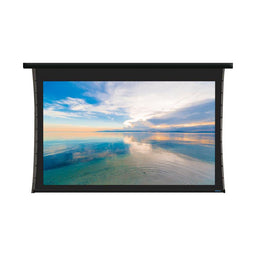
$6,097.06
- Status: Leaves Warehouse within 10-12 Weeks
- Screen Type: Electric
- Mount Type: ["Wall and Ceiling"]
- Viewable Diagonal: 135.0
- Gain: 1.1
- Viewable Height: 66.0
- Viewable Width: 118.0
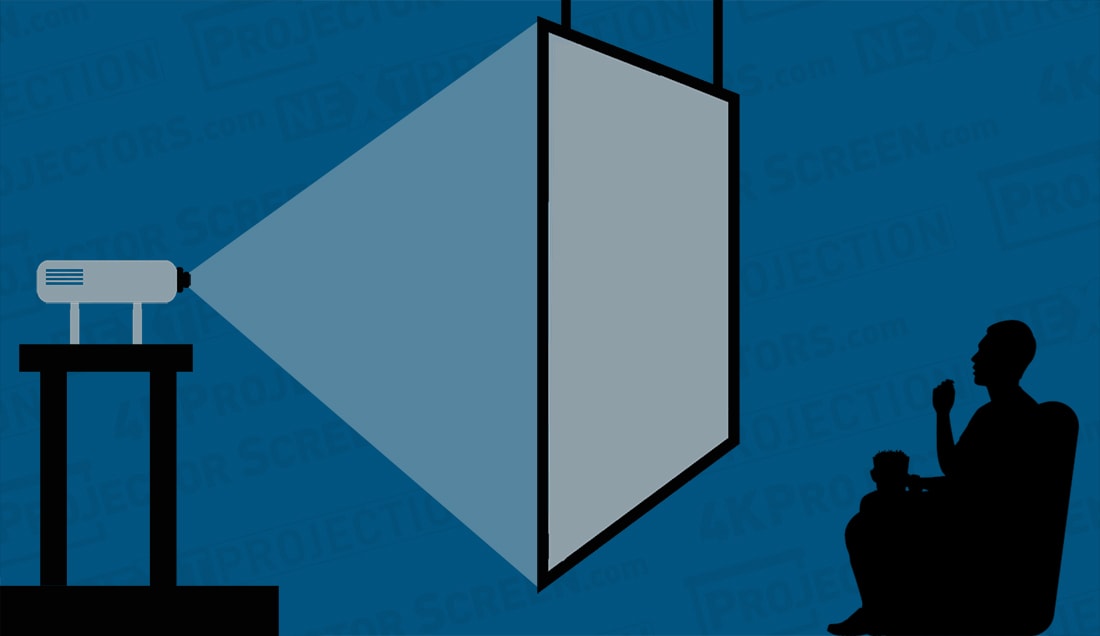
Rear Projection
Rear projection requires that the projector be positioned behind the screen. Rear projection surfaces are partially translucent.
Unlike front projection, rear projection surfaces are always tensioned by default. Because this configuration requires that the projector be placed behind the screen (facing the audience) one of the disadvantages of rear projection is that it requires more space than front projection.
Because of this, two way projection screens are less commonly found in home cinema rooms.
However, there is an advantage to rear projection over front projection - there’s less chance of someone obstructing the projected image. Rear projection is most commonly used in professional applications like trade-shows and large theaters.
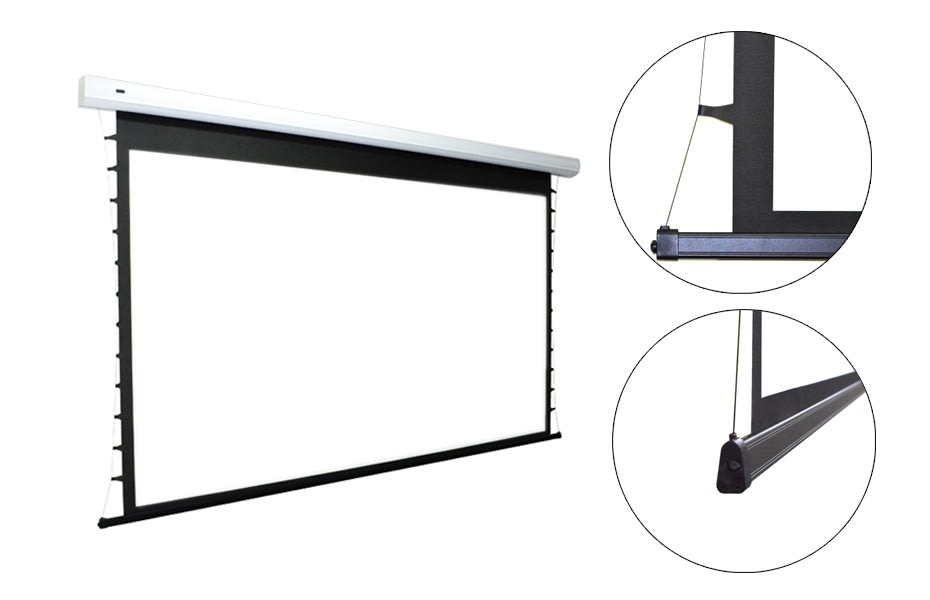
Tensioned
A tensioned projector screen refers to an electric or manual screen that has rods or a wire that pulls the screen material to present a flatter more uniform projection surface. The tensioning feature eliminates the occasional creasing, waviness or other imperfections a non tensioned screen might have. Tensioned electric screens are also necessary to support 4K and above resolutions.
Fixed frame screens are tensioned by default.
One of the pain differences you’ll find between cheap projector screens and quality is that premium ones will be tensioned giving you a much better picture quality.

Ultra Short Throw
An Ultra Short Throw projector screen is specially designed to enhance the image from an ultra short throw projector or laser TV. These projectors use special wide angle lenses and mirrors to “throw” the image onto the screen from a very short distance.
To help these UST projectors, the UST screens are ambient light rejecting and reflect light in such a way that only the light from the projector is reflected back to the viewer giving you a much brighter image.
- Build a Bundle
![Vividstorm S Lite Hyper Motorized Floor Rising ALR Projector Screen for Ultra Short Throw Projectors 150 Inch - VWSDSTLST150H - White - [CUSTOM]](http://www.projectorscreen.com/cdn/shop/files/SLiteHyper-White_b9d1dd4a-ec65-4161-b61a-72294c22b3ab.jpg?v=1753817337&width=256)
$2,987.00
- Status: Contact Us to Place Order
- Mount Type: ["Floor"]
- Viewable Diagonal: 150.0
- Gain: 0.8
- Viewable Height: 73.5
- Viewable Width: 130.74
- Sale
- Build a Bundle

$1,499.00
- Status: In Stock
- Mount Type: ["Wall"]
- Viewable Diagonal: 120.0
- Viewable Height: 58.8
- Viewable Width: 104.6
- Sale
- Build a Bundle

$799.00
- Status: In Stock
- Mount Type: ["Wall"]
- Viewable Diagonal: 100.0
- Viewable Height: 49.0
- Viewable Width: 87.0
Curved Projector Screen
As the name implies, a curved screen is slightly curled. A curved projection screen has several benefits for home cinema. The curved edge allows your peripheral vision to become more involved and immersed than the viewing on a flat screen.
This benefit is mostly seen when the curved screen is set up as a 2:35 to 1 or 2:4 to 1 aspect ratio. This is known as anamorphic widescreen and is most commonly seen in commercial movie theaters. You can also use curved screens using a Panamorph lens attachment to your projector.
Screen Format

A screen’s format can be best understood as the specific rectangular shape of the screen. Sometimes this is referred to as the projector screen’s aspect ratio. It tells you the ratio of width to height.
16:9 Projector Screen (HDTV Format)
The most common aspect ratio in home theater today is 16:9 (HDTV format). This is the aspect ratio that modern-day television content is broadcasted in. When you watch programs on Netflix, Amazon Prime, YouTube, Hulu, etc, or play video games, the format you will most likely encounter is 16:9.
If you plan to watch both TV and movies a 16:9 screen is the recommended aspect ratio.
16:10 (Widescreen)
Most computer screens are 16:10 format. The distinction between 16:9 and 16:10 is minimal. While the 16:9 shape has 9 units of height for every 16 units of width, 16:10 has 10 units of height for every 16 units of width.
Without closer inspection, they tend to look the same. However, their applications tend to be different. Since computers display in 16:10, this format is often the preferred choice in professional applications (conference rooms, board rooms, trade shows) as it allows you to get slightly more information on the screen than 16:9.
So if you're using your projector for business purposes a 16:10 projector screen is what we'd recommend.
Cinemascope (2.35:1 And 2.40:1)
2.35:1 Aspect Ratio
Classic films were most often shot using a 2.35:1 Cinemascope aspect ratio. So if you are a cinephile wanting the vintage movie theater experience in the privacy of your own home without the black bars, a 2.35:1 Cinemascope format is the way to go.
2.40:1 Aspect Ratio
For modern movie cinephiles, 2.40:1 Cinemascope is the way to go because most current films are shot with the 2.40:1 aspect ratio. So if you are wanting the contemporary movie theater experience in your own home theater, get a 2.40:1 Cinemascope projector screen.
4:3 (Video Format)
Video format is the original TV shape that was popular before many years ago, back when the TV was not a flat-screen - the old tube television, VHS and low resolution computer outputs.
The reason why 4:3 Video format still exists in the projection screen world is because it is a versatile design, not to mention that a lot of content still exists in its original 4:3 shape. In the case of 4:3 there are 4 units of width for every 3 units of height.
1:1 (Square Format)
While there’s almost no video content in square format, there is a reason that this format is still popular: for screens that can be adjusted, square format can accomplish all the other formats.
For example, if you’re using a tripod screen, you can lock the height of the screen at various points in order to achieve various aspect ratios.
Another reason square format screens still exist is that it is optimal for slide projectors or overhead projectors.
Masking (Multi Format)
A multi-format screen allows for more than one aspect ratio to be offered by employing a masking device. While most screens do not offer this feature, there are few select displays which do.
There are two kinds of masking: horizontal masking and vertical masking. In the case of horizontal masking it is the width of the screen that remains constant, and in vertical masking it is the height of the screen that remains constant. For example if you are watching cinemascope content on a 16:9 screen the height of the screen can be reduced to fit the aspect ratio with horizontal masking.
Projector Screen Size
Whoever said “size doesn’t matter” has never witnessed the glory of a 4K 120 inch projector screen in their home.
The size of the screen, both its width and height, will be limited by the dimensions of the wall you plan to install it on.
How Do You Measure The Screen Size?
Because there are so many different aspect ratios it would be difficult to compare a screen’s height or width. That’s why projector, television, computer and even phone screens are typically measured using the diagonal. This also allows you to compare surface areas much more easily.
What Size Projector Screen Should I Get?
The projector screen size you should get depends on what it’s being used for.
Some people’s personal preference is to have the largest screen possible while others prefer to have the optimal size to distance ratio for their screen.
Size For Home Theaters

If you’re planning to use it in your home theater you likely want a screen between 100 inches and 150 inches. This of course depends on the size of your media room and where you’d be sitting.
Size For Large Venues

If you’re planning to use it for a larger space like a church projector screen or other large venue you’ll likely want to get a screen over 150 inches.
How Much Does A Projector Screen Cost?
The cost of a projector screen can run from $50 for a cheap projector screen to $4000 for a premium home theater screen to tens of thousands of dollars for very large screens that you would find in a commercial movie theater.
When it comes to quality items that are worth getting, most home cinema screens cost between $400 and $4000.
The projection screen price is determined by a number of factors like the size of the screen, the type of screen it is, the type of surface it is and the special features.
Why Do Premium Projector Screens Cost So Much?
While you can find a cheap projector screen for under $100, these screens are little better than a bed sheet and about the size of a hand towel.
A premium cinema screen on the other hand is a scientifically engineered piece of technology.
- They’re made with higher grade parts and longer lasting material.
- They give you significantly better picture quality.
- They bring out the best in your projector.
- They have better warranties and lower defect rates.
Is A Projector Screen Worth It?
Yes projector screens are worth it! While there might be some initial sticker shock, when you see the image projected on a 120 4K projector screen you instantly know that your screen was one of the best purchases you’ve ever made.
Where Should You Put Your Projector Screen?
Determining where to place your projector screen is crucial for achieving optimal image quality and viewing comfort. Here are some quick tips for screen placement:
- Central Location: Position the screen in the center of the wall for balanced viewing angles from all seating positions.
- Avoid Direct Sunlight: Choose a location where the screen won't be affected by direct sunlight or harsh artificial lighting, as this can wash out the image and reduce contrast.
- Consider Viewing Distance: Ensure there's enough distance between the screen and the seating area to accommodate comfortable viewing. Follow recommended guidelines based on screen size and resolution for optimal viewing angles.
- Minimize Obstructions: Avoid placing the screen where it may be obstructed by furniture, columns, or other obstacles that could interfere with the projection or viewing experience.
- Room Acoustics: Take into account the room's acoustics when positioning the screen. Avoid placing the screen too close to reflective surfaces such as windows or bare walls, which can cause audio reflections and distortions.
- Screen Height: Mount the screen at an appropriate height for clear visibility from all seating positions. The bottom third of the screen should be at eye level when seated for comfortable viewing.
- Accessible Power Outlets: Ensure easy access to power outlets for the projector and any motorized screen mechanisms if applicable.
- Consider Screen Type: Depending on the screen type (fixed-frame, retractable, motorized), allow space for installation and operation, including clearance for wall or ceiling mounts.
- Test Projection Placement: Before finalizing screen placement, conduct a test projection to ensure optimal image quality, brightness, and alignment from the desired viewing positions.
By following these placement tips, you can choose the best location for your projection screen to create an immersive and enjoyable viewing experience for yourself and your audience.
Where Should You Put Your Projector Screen In Your Home Theater?
The general recommendation, for where to put your projector screen in a home theater is 10“ to 12” of screen diagonal for each foot of viewing distance. That distance is eyes to screen. It's a pretty simple calculation.
If you will be sitting 10' away, then a 100“ to 120” diagonal is ‘typical’. 100“ would give you the center of theater feel. 120” is a bit closer than the center of the theater. It comes down to personal preference.
There is usually only one wall in your media room that the video screen would work best on. You should try to put the projection surface on a wall that has no direct light shining on it. The more light that hits the display surface, the more washed out the picture on it will look.
If the light in the room cannot be completely controlled, you might want to consider an ambient light rejecting screen.
Our experts suggest the bottom of the screen be between 2 to 3 feet off of the floor. This allows you to have the optimal viewing height.
Of course, this depends on the size of your screen and the wall you’re placing it on.
If you have multiple rows of theater seating in your cinema room, you may need to go a bit higher to keep clean lines of sight for people sitting behind the first row.
Also make sure to take into account anything that will sit underneath the display, like a center speaker or an entertainment center.

Viewing Angles
One thing you need to take into account when buying a projector screen are the viewing angles. The viewing angle is the angle the screen traverses in the viewer’s front vision from the far left of the screen to the far right.
It’s recommended that you have a viewing angle between 30 to 40 degrees for optimal viewing. At wider angles the image will appear dimmer and washed out because the light reflecting of the screen isn’t reflecting as much at that angle.
Some projection screens have wider viewing angles than others. So if you’re planning to use your display in a wider room, you need to make sure it has a wider viewing angle.
Sightlines
If you have more than one row in your home movie theater, the rows behind the first could be blocked by heads of the viewers in the first. You can use risers or horizontally stager the seating layouts. The other option you have is to place the screen higher on the wall.
Projector Screen Brands
At ProjectorScreen.com we only carry the highest quality film screen brands. Get to know some of the brands we have on our website.
-
Screen Innovations
- About the company: Screen Innovations is not your traditional screen. Since 2003 SI have designed, engineered, and hand-built projection screens for the custom integrator from their facility in Austin TX, USA.
- Price range: $1,000-$55,000
- Specialty: 4K+ resolution projection screens, best known for their Black Diamond ambient light rejecting screens
- Custom screens available
- Made in the USA
-
Stewart Filmscreen
- About the company: Stewart has been leading the projector screen industry for over seventy years. All Stewart screens are made in the USA and can provide the largest seamless screen of any manufacturer. What's even more impressive is that Stewart Filmscreen is a family-owned company still after all these decades.
- Price range: $1,300-$15,000
- Specialty: 4k-16k+ resolution projector screens, best known for their StudioTek reference screen materials
- Custom screens available
- Made in the USA
-
Elite Screens
- About the company: Elite Screens started out as a relative newcomer in the industry over 10 years ago. Since then, they've firmly established themselves as one of the audio-visual world's most recognizable brands when it comes to projection screens. They are especially well-known for producing products that are highly affordable on even tight budgets, but which sacrifice nothing when it comes to precision and efficiency.
- Price range:$120-$9,000
- Specialty: Economical projector screens
-
Da-lite
- About the company: Founded in Warsaw Indiana in 1909, Da-Lite was there at the beginning of the moving picture industry. In what has now been more than a century of projector screen development, Da-Lite has been at the cutting edge with each and every technological twist in turn that has taken place.
- Price range: $130-$38,000
- Specialty: Projector screens for K-12, Higher Ed, House of Worship and other commercial applications
- Custom screens available
- Made in the USA
-
Draper
- About the company: Draper Inc is one of the preeminent manufacturers of projector screens based in the USA. Based out of Spiceland Indiana. Draper is one of the longest lasting (and family-owned) manufacturers in the country today. Draper entered the projector screen field toward the end of the 1950s. Their displays are frequently found in classrooms and boardrooms across the country.
- Price range: $120- $24,000
- Specialty: Projector screens for K-12, Higher Ed, House of Worship and other commercial applications
- Custom screens available
-
Spectra Projection
- About the company: Spectra Projection is a relatively new comer to the world of projection, but don't let that fool you these innovators make high quality screens for an affordable price. They were the first to manufacture 150 inch ultra shrot throw projection screens.
- Price range: $1300-$5000
- Specialty: High quality, affordable ultra short throw projector screens
-
Vividstorm
- About the company: Since 2004 Vividstorm has been bringing high-quality products, great customer service and an unparalleled value to the projection screen market. They saw a lack of motorized ultra short throw cinema screens and filled that gap with affordable floor rising models that feature high performance ambient light rejecting surfaces.
- Price range: $1800-$2300
- Specialty: Floor rising retractable ultra short throw screens
-
Grandview
- About the company: Grandview Screen is a global leading projection screen manufacturer, offering a complete line of internationally recognized and regarded screens. Decades of engineering and production experience; pioneering the frontier for Projection Screens.
- Price range: $900-$1700
- Specialty: The most economical true 4k projection surfaces
-
Elunevision
- About the company: Since they were first established in 2006, Elunevision has been a consistent and ongoing source of innovative, fresh, reliable audio-visual product lines capable of satisfying even the most discriminating consumer.
- Price range: $1100-$6000
- Specialty: Economical 4k projection screens
What Is The Best Screen Brand?
There are a number of projector screen manufactures but deciding which is the best projector screen brand is somewhat subjective. Some brands are better at certain features than others.
If you want to buy the best projection screen there are a few attributes you should look for.
Where Is The Screen Made?
You want to look for a brand that manufacturers in the United States. When you buy a made in the USA projector screen, you can be more confident that you’ll be getting a higher quality screen built with better quality materials and components so they’re likely to last longer.
Another advantage is that they’re more likely to arrive without damage because they don’t have to come from overseas. This is the reason American screen manufacturers are able to offer more substantial warranties.
Projector Screen Warranties
Speaking of warranties for projector screens, you want to make sure the manufacturer offers at least a 5-10 year warranty.
Motorized movie screens should especially have a 5-10 year warranty as they contain moving parts that have a higher chance of breaking than a fixed frame that doesn’t go up and down.
How Is Their Customer Service?
Any time you buy an expensive item you want to know that customer service will be there to help you should any issues arise. The best movie screen manufacturers provide excellent customer service.
You can check out company reviews to get an idea of their customer service.
Projector Screen Pricing
The price of projector screens is a good indicator of which one is the best. A brand that sells higher priced screens is going to offer a better product.
It’s important to remember though that what you’re really looking for is the value of your projector screen. For many people getting the most expensive projector screen isn’t necessarily the best option for them.
Shop Our Huge Selection Of Projector Screens For Sale
